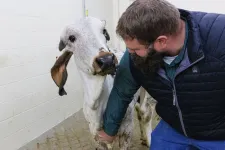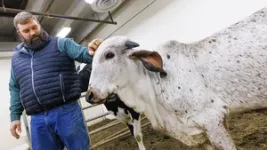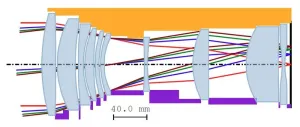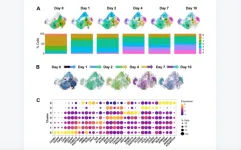(Press-News.org) Cattle worldwide face major health threats from a highly infectious viral disease that decades of vaccinations and other precautions have failed to contain. Federal, private-sector and Husker scientists are collaborating on a new line of defense, by producing a gene-edited calf resistant to the virus.
If follow-up research confirms its efficacy, the gene-editing approach offers long-term potential to reduce antimicrobial and antibiotic use in the cattle industry.
The bovine viral diarrhea virus (BVDV) devastates the bovine immune system and can cause severe respiratory and intestinal harm to infected beef and dairy cattle, said veterinary epidemiologist Brian Vander Ley, an associate professor in the University of Nebraska-Lincoln’s School of Veterinary Medicine and Biomedical Sciences.
In utero calves are especially vulnerable to infection. If they survive, they can remain infected for life, repeatedly spreading the virus to other cattle.
“They show up as normal cattle but really, they’re shedding a tremendous amount of virus. They’re the ‘Typhoid Marys’ of BVDV spread,” said Vander Ley, assistant director of UNL’s Great Plains Veterinary Educational Center in Clay Center.
The cattle industry has vaccinated against the disease since the 1960s, but “the highly mutable nature of BVDV and the emergence of highly virulent strains of BVDV contribute to limited success of present control programs,” the Academy of Veterinary Consultants has stated.
Scientists identified the specific genetic structure associated with the disease earlier this century. A collaborative project involving scientists with the USDA’s Agricultural Research Service and Acceligen, a Minnesota-based private company, used gene editing to change the small number of amino acids that lead to BVDV vulnerability, while keeping the rest of the protein, CD46, unchanged.
“Our objective was to use gene-editing technology to slightly alter CD46 so it wouldn't bind the virus yet would retain all its normal bovine functions,” said Aspen Workman, a scientist with ARS’ U.S. Meat Animal Research Center (USMARC) in Clay Center, Nebraska.
A gene-edited calf, named Ginger, was born on July 19, 2021, and was transported to UNL a week later for close monitoring by Vander Ley. Throughout, Ginger has remained a “bright, healthy calf,” normal both physically and behaviorally, which included a week with a BVDV-infected dairy calf that was shedding the virus in great volume.
The research findings will be published online May 9, by the PNAS Nexus open-access journal, a sibling publication to the Proceedings of the National Academy of Sciences. Workman is lead author.
Ginger is a Gir, a tropically adapted cattle breed used to develop Brahman cattle in North America. Follow-up research will require experimental replication in other cattle breeds. Ginger also will be monitored through pregnancy, if it occurs.
If the gene-editing approach proves viable, it could potentially reduce the cattle sector’s use of antimicrobials, Vander Ley said.
“The most successful version of the future that I can see is one where we don't have to deal with antimicrobial resistance because we just don't use that many antimicrobials,” he said. “That's better for everyone. That means that we have eliminated the cause of a lot of the antimicrobial use and we've eliminated that expense for livestock producers.”
Michael Heaton, a USMARC researcher for the BVDV project, concurred. This line of research “represents another opportunity to lessen the need for antibiotics in agriculture,” he said.
In addition to Vander Ley, Workman and Heaton, other study coauthors are Erin E. Jobman (Great Plains Veterinary Educational Center); Gregory P. Harhay (USMARC); private-sector scientists Tad S. Sonstegard, Dennis A. Webster, Luke Sherry, Sabreena Larson, Daniel F. Carlson and Jonathan Bostrom; and Theodore S. Kalbfleisch with the University of Kentucky.
END
Gene-edited calf may reduce reliance on antimicrobials against cattle disease
First gene-edited calf with reduced susceptibility to a major viral pathogen
2023-05-09
ELSE PRESS RELEASES FROM THIS DATE:
Scientists at uOttawa streamline a widely used chemical reaction, creating new manufacturing opportunities
2023-05-09
A team of scientists from the University of Ottawa has developed an innovative technique to manufacture complex chemical structures from easily accessible substrates, making it one of the simplest and most practical methods for converting alcohols into their arylated equivalents.
This innovative method for performing the reaction, namely the deoxygenative Suzuki-Miyaura arylation of aliphatic alcohols, uses two distinct metal catalysts. Their reaction operates under mild reaction conditions with minimal waste products and is expected to have a significant impact on the creation of new molecules. As a result, it will contribute to advances in pharmaceutical, agrochemical, ...
Designing cameras for harsh environments? Be sure to account for lens mount details
2023-05-09
Cameras used in harsh environments must be designed in a way that prevents temperature swings from influencing their optical performance. New research demonstrates that accounting for the exact lens mounting structure used is a critical step in ensuring that lens systems remain robust to temperature changes.
Eric M. Schiesser from Synopsys, Inc. will present the new research at the Optica Design and Fabrication Conference, which will take place 04 – 08 June 2023 in Quebec City, Canada.
“Most optical systems – from the camera in your smartphone to the eyes of the Mars rover - are used over a range of temperatures. To keep the image sharp ...
New study led by Brown researchers sheds light on incidental findings in lung cancer screening
2023-05-09
PROVIDENCE, R.I. [Brown University]—When patients receive a low-dose computed tomography screen for lung cancer, doctors can see more than just the lungs. The screening test often picks up abnormalities or potentially “significant incidental findings” (SIFS) not associated with lung cancer. A new study led by Ilana Gareen, an associate professor of epidemiology at the Brown University School of Public Health, and published in JAMA Internal Medicine, highlights the need for proper reporting and management of these findings to reduce mortality, health care costs and unnecessary ...
Single-cell transcriptomic analysis uncovers diverse and dynamic senescent cell populations
2023-05-09
“In summary, single-cell transcriptomic analysis has allowed us to identify the specific populations and the dynamic transition states during senescence initiation and progression.”
BUFFALO, NY- May 9, 2023 – A new research paper was published in Aging (listed by MEDLINE/PubMed as "Aging (Albany NY)" and "Aging-US" by Web of Science) Volume 15, Issue 8, entitled, “Single-cell transcriptomic analysis uncovers diverse and dynamic senescent cell populations.”
Senescence is a state of enduring growth arrest triggered by sublethal cell damage. Given that senescent cells actively ...
Variants of MRTFB gene linked to novel neurodevelopmental disorder
2023-05-09
Researchers at Baylor College of Medicine have linked specific variants or mutations of the gene myocardin-related transcription factor B (MRTFB) with a novel neurodevelopmental disorder. The team reports in the journal Genetics in Medicine that they were able to find variants in this gene in patients whose neurodevelopment disorders had previously gone undiagnosed. The research also revealed that the mutations disrupt the way the MRTFB protein controls other genes in the cell and this cascades to affect hundreds of other genes.
“We identified ...
Change in breast density over time linked to cancer risk
2023-05-09
Many middle-aged and older women get mammograms every one to two years to screen for breast cancer, as recommended by their doctors. A study by researchers at Washington University School of Medicine in St. Louis indicates that previous mammograms hold underutilized data that could help identify women at high risk of breast cancer and even reveal which breast is likely to be affected.
When doctors read mammograms, they assess breast density along with signs of cancer, comparing a woman’s previous mammograms to her most recent one to look for worrisome changes. But some changes are difficult to ...
New study suggests that SARS-CoV-2 might induce lasting pain in unique way
2023-05-09
(Boston)—COVID-19, the disease resulting from SARS-CoV-2 infection, is associated with highly variable clinical outcomes that range from asymptomatic disease to death. For those with milder infections, COVID-19 can produce respiratory infection symptoms (cough, congestion, fever) and sensory phenotypes such as headache and loss of sense of smell. In more severe cases, SARS-CoV-2 infection can affect nearly every organ and result in strokes from vascular occlusion, cardiovascular damage and acute renal failure. ...
New method uses engineered bacteria and AI to sense and record environmental signals
2023-05-09
New Method Uses Engineered Bacteria and AI to Sense and Record Environmental Signals
Columbia synthetic biologists first to engineer bacterial swarm patterns to visibly record environment, use deep learning to decode patterns; applications could range from monitoring environmental pollution to building living materials
New York, NY—May 9, 2023—Researchers in Biomedical Engineering Professor Tal Danino’s lab were brainstorming several years ago about how they could engineer and apply naturally-pattern-forming bacteria. There are many bacteria species, such as Proteus mirabilis (P. mirabilis), that self-organize into defined patterns on solid surfaces that are visible ...
Increasing prosperity linked to unhealthy eating patterns in Kenyan youth
2023-05-09
Philadelphia, May 9, 2023 – The increase in obesity in lower-middle-income countries (LMIC) is largely thought to be affected by lifestyle transition away from traditional diets toward unhealthy Western dietary patterns that follow economic development. This study in the Journal of Nutrition Education and Behavior, published by Elsevier, collected data on eating and physical activity behaviors from families in two socioeconomically-different communities in Nairobi, Kenya. Researchers found that increasing prosperity is linked to unhealthy eating patterns in Kenyan preadolescents.
"Dietary ...
Systematic racism in healthcare boosted COVID-19 vaccine mistrust in Black communities: Study
2023-05-09
The University of Ottawa’s Interdisciplinary Centre for Black Health survey reveals scope of coronavirus vaccine hesitancy in Black communities in relation to healthcare.
The health care system must play a significant role in combatting COVID-19 mistrust among Black individuals in Canada according to a new University of Ottawa study that found distrust in the healthcare network was so profound that educated individuals were hesitant to receive the vaccine.
Professor Jude Mary Cénat, Associate Professor in the School of Psychology at the Faculty of Social Sciences, is the Chair of the Interdisciplinary Centre ...
LAST 30 PRESS RELEASES:
Numbers in our sights affect how we perceive space
SIMJ announces global collaborative book project in commemoration of its 75th anniversary
Air pollution exposure and birth weight
Obstructive sleep apnea risk and mental health conditions among older adults
How talking slows eye movements behind the wheel
The Ceramic Society of Japan’s Oxoate Ceramics Research Association launches new international book project
Heart-brain connection: international study reveals the role of the vagus nerve in keeping the heart young
Researchers identify Rb1 as a predictive biomarker for a new therapeutic strategy in some breast cancers
Survey reveals ethical gaps slowing AI adoption in pediatric surgery
Stimulant ADHD medications work differently than thought
AI overestimates how smart people are, according to HSE economists
HSE researchers create genome-wide map of quadruplexes
Scientists boost cell "powerhouses" to burn more calories
Automatic label checking: The missing step in making reliable medical AI
Low daily alcohol intake linked to 50% heightened mouth cancer risk in India
American Meteorological Society announces Rick Spinrad as 2026 President-Elect
Biomass-based carbon capture spotlighted in newly released global climate webinar recording
Illuminating invisible nano pollutants: advanced bioimaging tracks the full journey of emerging nanoscale contaminants in living systems
How does age affect recovery from spinal cord injury?
Novel AI tool offers prognosis for patients with head and neck cancer
Fathers’ microplastic exposure tied to their children’s metabolic problems
Research validates laboratory model for studying high-grade serous ovarian cancer
SIR 2026 delivers transformative breakthroughs in minimally invasive medicine to improve patient care
Stem Cell Reports most downloaded papers of 2025 highlight the breadth and impact of stem cell research
Oxford-led study estimates NHS spends around 3% of its primary and secondary care budget on the health impacts of heat and cold in England
A researcher’s long quest leads to a smart composite breakthrough
Urban wild bees act as “microbial sensors” of city health.
New study finds where you live affects recovery after a hip fracture
Forecasting the impact of fully automated vehicle adoption on US road traffic injuries
Alcohol-related hospitalizations from 2016 to 2022
[Press-News.org] Gene-edited calf may reduce reliance on antimicrobials against cattle diseaseFirst gene-edited calf with reduced susceptibility to a major viral pathogen






